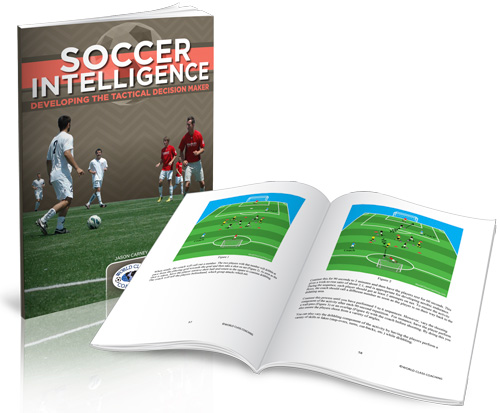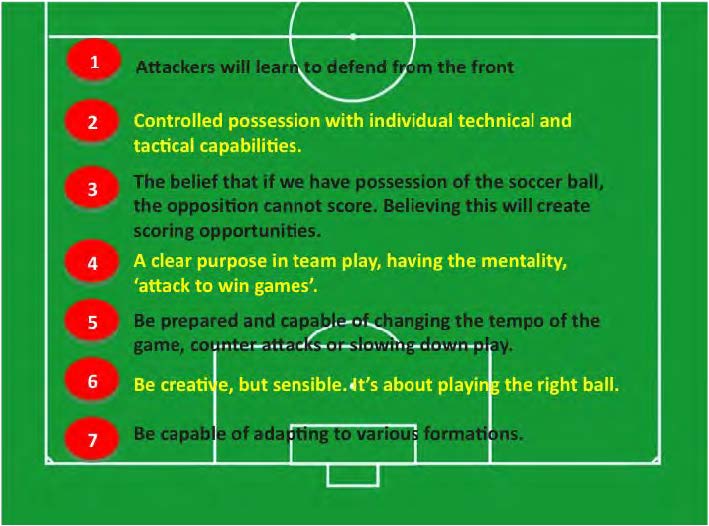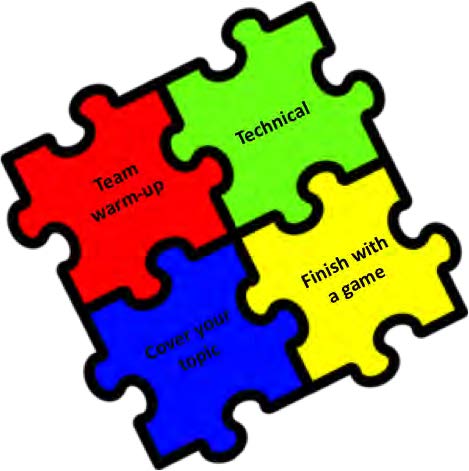WORLD CLASS COACHING
Soccer Intelligence
By Jason Carney

TABLE OF CONTENTS
Part Five
PLANNING A TRAINING SESSION
You are the head coach, what next?
Make your players feel important
Work alongside good people. Having someone to talk to someone to bounce ideas off is so crucial for you and the team.
Work on the philosophy that no one is bigger than the team. All-star players need their team-mates to perform. If you have star players, then sell this philosophy to them. As the coach, you are part of the team. Show a willingness to listen and a work ethic that is second to none. Start to quickly understand your players.
You cannot treat everyone the same. The rules apply to everyone but human beings are different from each other. No matter what the level of play you are coaching, give a premier service. Set goals but also understand where the group is at. The goals have to be realistic. All players can develop and improve with quality coaching. Hold the players accountable for their actions. We are teaching life lessons, no matter what level of soccer we are coaching.
Team building
The pieces have to fit
Getting the best team does not necessarily mean having the best players. As the coach you are going to have to sell the team philosophy to your players.
• We will achieve more if we work together.
• We will achieve more if we stay positive and encourage each other.
• We will achieve more if we accept responsibility for our position on the team.
• We know bad times will come. We will stay as a unit and be strong.
A good coach understands that being on target and understanding the strengths of the team is more important than winning. A coach has self-belief when he/she is not concerned about results. They have that self-belief that if the team (which includes the coach) can stay the course of the plan, then winning will come.
Installing teamwork is not easy. It does not just appear. It has to be worked on, just like tactics and techniques. Sometimes we are inheriting players that come from a social background of “Me, me, me.” These day’s parents are so protective of their children that team building can be misconstrued. If a child does not do as well as expected, we look to blame others instead of staying positive and helping the player overcome the poor performance by other means than to play the “blame game.”
The players must know the philosophy of the coach. What is expected of the players when possession is gained and lost?
Attacking
1. Quality passing – Accuracy, weight and timing. Using both feet and a variety of foot surfaces.
2. Possession – Keeping possession and getting out of trouble in tight spaces (Includes using the goalkeeper).
3. Transition – The quick change in thought process when possession is won.
4. Receiving & support – Receiving ground and air balls while on the move. Protecting the ball by shielding (Includes the goalkeeper).
5. Movement – Understanding and implementing movement patterns.
6. Individual & player combination – Running with the ball and 1 v 1 dribbling. Give and go’s (Goalkeeper distribution).
7. Goal scoring – Crossing and finishing and shooting in realistic situations.

Defending
1. Delaying and denying progress – Contain when defenders against higher numbers.
2. Pressurizing – Working together as a team.
3. Transition – The quick change in thought process when possession is lost.
4. Tackling – Coach the correct tackling techniques

The coach is the mirror image of the team
Your players are a reflection of you
Coaches must have a vision. That vision has to include, your character, team building, techniques, formations and style of play. You can only instill discipline if you are disciplined yourself. If you are late for practices or you yell at the officials, what do you think your players will do?
If a coach’s actions or commitments drop, then the players enthusiasm for the team will drop. You cannot expect your players to handle stress if you yell at the officials from the sidelines. Teach the players to do their best. Sometimes they will come across situations that are out of their hands. They have to learn to overcome obstacles.
Below are a few characteristics that recognize a good coach:
• Great attitude
• Commitment
• Patience
• Humor
• Studies the game and is prepared to change with the times
• Realistic
• Common sense
• Approachable
• Open minded
When you are choosing your team, look for players that are capable of being a team player. Look for personality. We all know that speed, technique and intelligence are key values in creating a successful soccer player but the one thing that is difficult to coach, is personality. Which one would you take on your team?
Good player with a terrible attitude? Average player with an excellent attitude? It would be nice to get the excellent player with the excellent attitude, but in the realms of amateur soccer, we come across the first two scenarios the most.
How do you plan a practice session?
Provide the foundation that involves learning from which players develop.
The reason for coaching is to ensure that the players stay in the game longer and learn valuable life lessons along the way. Every practice session must have a purpose, and the players have to be challenged both mentally and physically. Planning a practice session is not an easy process. It becomes easier once you know your players and their strengths. For your players to improve, they rely on a well organized practice session.
Once the practice session has been planned, you are now ready to execute. You have to be clear in your delivery, you have to incorporate the elements that relate to the game and the physical, technical and tactical skills that reflect realism. Players will now understand that there is a goal to the practice. There is a purpose to what they are doing. Create an atmosphere where the players have to step away from their comfort zone. The session will include decision making, problem solving and involve decisions that will create game intelligence.

The reason for coaching is to ensure that the players stay in the game longer and learn valuable life lessons along the way. Every practice session must have a purpose, and the players have to be challenged both mentally and physically.
Format:
• Provide the foundations that constitute a learning basis from which players construct and develop playing skills and game intelligence (decision making)
• The topic of the practice session (planning and organization)
• Objective of the practice session (elements that relate to the game)
• Cover the coaching points (good delivery)
• The variation or progression of the practice session if applicable
• The practice sessions must reflect the game
• Ball technique exercises should provide plenty of physical activity. A few motivational running competitions and agility training are sufficient
Technique – The natural starting point in the development of a player is getting the body into a good position to receive the ball. Choosing the proper body part to receive the ball, being strong and balanced on your feet, and then applying the proper touch on the ball are all essentials in building a solid foundation for good technique.
Instruct your players to receive the ball on the ‘half-turn’ as this will give the players many more options. Receiving the ball using the ‘back foot’ requires the player to have the correct body shape. This will help the player move the ball more comfortably and quickly. When time and space become a premium, players with better technique will have more time on the ball and be more successful when using the ball.
An absolute priority is to develop a clean first touch. Receiving and position of the ball as it arrives, allows more time to release the ball with an accurate, well timed and well-paced pass. The first touch is the key to becoming a quality player. A good first touch allows you to keep the ball or to play it off first time, thus creating a serious problem for the defender. Good technique can find an answer to a game situation more quickly.
Attacking Play - With a solid grounding of technique established, you can now begin to coach your players in attacking play. The greater the control a player has in the final third, the greater the chance to dictate to your opponents. It is especially important to keep the ball and probe for scoring possibilities.
In attacking play, all the players must contribute, from the keeper, the backs to the forwards, everyone has a role to play. The key to good attacking play is passing angles. Running, passing and looking in straight lines narrows the view of the game and lacks creativity. It is important to pass short and long and to play angles, not just straight lines. Your players must be able to decide for themselves what play is available by moving into areas that will cause the opposition problems. The decision on the pass, the accuracy, the weight and the timing of the pass is now key in creating that shooting chance.
Players have to understand the moments of when to dribble, shoot or when to pass. Playing a passing game does not mean that you cannot dribble. Players must see the moment when you can create a “numbers up” situation (2v1). If the opposition sees the danger and have sufficient cover, don’t dribble. Move the ball with a pass to get away from that danger.
Third Man’ Running - It is more than just the player with the ball and one player off it; passing must include consideration for the ‘third man’. In teaching a player ‘third man’ running, pay attention to wide angles and avoid straight line running. When you make wide runs, you open up more room to play into.
The art of the ‘third man’ running is in the speed of execution. With constant practice and repetition, this will become automatic when the game pressure kicks in. An example of a third man run is when player A passes to player B and player A continues their run. Player B passes to player C who passes to the continuing running player A. This is what is known as “Third man running.”
Foundation phase – Quality planned session: No matter how experienced the coach is, preparing your practice sessions is essential in creating a session with rhythm. By planning, a coach can visualize the session to see whether or not it will work for the level of player he / she is coaching and also they will be able to work out the timing of the exercises and the transition to the next phase of the session. Players do not want to be standing around waiting for the coach to set up the next exercise.
Intelligence, decision making: Getting players making decisions at an early age is crucial in their development. Once the players move to the development phase and 11 v 11, tactical decisions will be easier for the player because they will have confidence when receiving tactical instructions from the coach.
Intensity: The coach has to be firm but fair. The technical points must be covered by the coach. Show the players once and make sure the technical aspects are carried out. If the coach sees mistakes, keep the exercises moving and comment while play is moving. If you feel like demonstrating again, go in there, show a quick demonstration and let the players go again.
Competitive: Some technical exercises can be made competitive with some creative coaching. Adding the small sided games at the end of practice will really help to develop competitive players.


